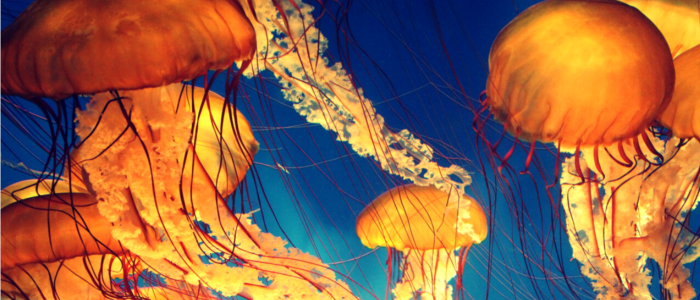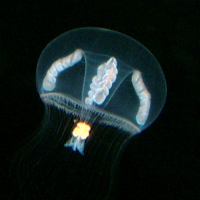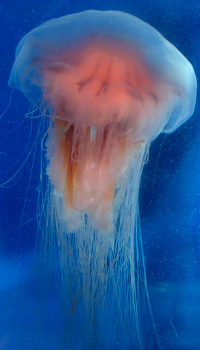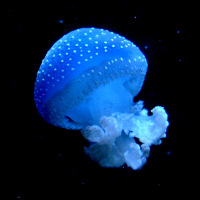
Since 2008, the Akron Zoo’s temporary exhibit space has been home to several deep sea dwellers, fascinating fish and curious creatures. Every 4-5 years we remodel to bring you a new and exciting animal experience. However, despite these changes, there has always been one constant presence: our jellyfish.
It is no secret that people find jellyfish intriguing. On November 3, we celebrate World Jellyfish Day, an observance that honors these unique animals and gives us the opportunity to learn more about them! As part of the festivities, we thought we would bring you some fun and mysterious facts about our squishy friends!
Jellyfish are some of the oldest occupants of our planet. Even though they have no bones to leave behind fossils, scientists have evidence that jellies have been around the last 500-700 million years. This makes them almost three times as old as the dinosaurs! Today they can be found in every ocean on the planet, as well as some freshwater habitats, such as river valleys.
 Jellyfish are not actually fish, they are gelatinous zooplankton. These invertebrates have bodies made up of as much as 98% water and very little else. They have a basic nervous system, often referred to as a nerve net, and are oxygenated by diffusion, so they have no need for brains or hearts.
Jellyfish are not actually fish, they are gelatinous zooplankton. These invertebrates have bodies made up of as much as 98% water and very little else. They have a basic nervous system, often referred to as a nerve net, and are oxygenated by diffusion, so they have no need for brains or hearts.
Despite their minimalist body designs, jellyfish have many unusual characteristics which are unique to each species. Some jellies, mostly deep-sea dwellers, have bioluminescent organs which utilize green fluorescent protein (GFP) to create a light that lures their prey. The box jellyfish, on the other hand, has 24 eyes and is the only species in the world thought to have 360 degree vision!
Jellies have also eliminated the need for extra bodily orifices, and have a single hole that serves every intake and output function (eating and pooping). Though they usually eat other marine larvae, fish eggs and other zooplankton, two aquarium keepers in Dallas, Texas have allowed their moon jellies to eat a saltwater/peanut butter mix. It seems you can have peanut butter and jellyfish, as the jellies found the mixture to be an acceptable source of protein!
 Many animals also eat jellyfish, including tuna, sharks, sea turtles and even humans! In Japan and Korea, jellyfish are a delicacy. People in Japan have even found a method of making sweet and salty caramel from sugar, starch syrup and jellyfish powder. This helps to reduce invasive jellyfish blooms along the coastline. Unfortunately, since there is so much plastic waste in our oceans, plastic bags are often mistaken for these invertebrates. Many of the jellyfish’s predators are on the decline, and hundreds of species have become endangered from ingestion of plastics.
Many animals also eat jellyfish, including tuna, sharks, sea turtles and even humans! In Japan and Korea, jellyfish are a delicacy. People in Japan have even found a method of making sweet and salty caramel from sugar, starch syrup and jellyfish powder. This helps to reduce invasive jellyfish blooms along the coastline. Unfortunately, since there is so much plastic waste in our oceans, plastic bags are often mistaken for these invertebrates. Many of the jellyfish’s predators are on the decline, and hundreds of species have become endangered from ingestion of plastics.
Jellyfish often travel in groups known as a swarm, smack or bloom. These groups may contain as many as 100,000 jellyfish. Not only do blooms range in size, but so do the jellies themselves. Jellyfish may be as small as 0.5 mm in diameter or as large as the titanic Nomura's jellyfish, whose bell can reach 6.5 feet across and weigh up to 440 pounds. Tentacle length also varies with jellies and may reach up to 120 feet, as in the case of the lion’s mane jellyfish.
Much like frogs and butterflies, there are several stages of the jellyfish life cycle. Egg cells are fertilized in the water and independently develop into planula larvae. When these larvae reach the ocean floor, they develop into a polyp, which attaches itself to coral and begins to eat and grow. Polyps will then bud and produce ephyra larvae, which grow into the medusa phase, or the mature jellyfish many of us recognize.
Though this is one path of development, it is not the only way jellyfish are born; some jellyfish are created in a cloning process. If a jellyfish is cut in two, both pieces can regenerate the rest of the animal’s body, resulting in two genetically identical, full-grown organisms. This can potentially lead to hundreds of offspring in the jellyfish’s lifetime. Other jellyfish, such as the immortal jellyfish, can travel backward through their lifecycle in times of stress to become polyps. They are the only species on Earth that is biologically immortal.
 Despite lacking brains, jellyfish have contributed to several scientific fields. The GFP from jellyfish is currently being tested in medical research to mark gene sequences using nanotechnology. The efficient movement of jellyfish has also inspired new types of robotic propulsion, both underwater and in the air, which may someday lead to the advancement of undersea and aerial vehicles. The sky isn’t even the limit for these invertebrates; thanks to NASA in the 1990’s, jellyfish have traveled to space! Both humans and jellyfish rely on gravity-sensitive calcium crystals to orient ourselves and by studying how jellyfish manage in space, scientists were able to gain unique insight into how a zero-gravity environment affects humans.
Despite lacking brains, jellyfish have contributed to several scientific fields. The GFP from jellyfish is currently being tested in medical research to mark gene sequences using nanotechnology. The efficient movement of jellyfish has also inspired new types of robotic propulsion, both underwater and in the air, which may someday lead to the advancement of undersea and aerial vehicles. The sky isn’t even the limit for these invertebrates; thanks to NASA in the 1990’s, jellyfish have traveled to space! Both humans and jellyfish rely on gravity-sensitive calcium crystals to orient ourselves and by studying how jellyfish manage in space, scientists were able to gain unique insight into how a zero-gravity environment affects humans.
If you would like to visit some jellyfish, be sure to stop by your Akron Zoo! Curious Creatures, which opened in 2017, features several animals with strange adaptations and unusual characteristics, including our jellyfish. But be quick! These habitats won’t be here for long!
